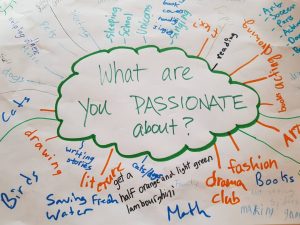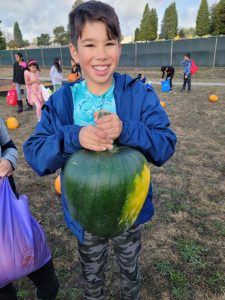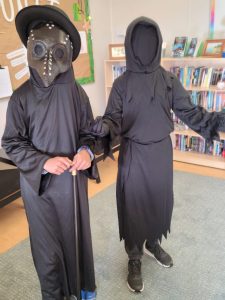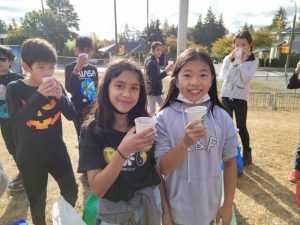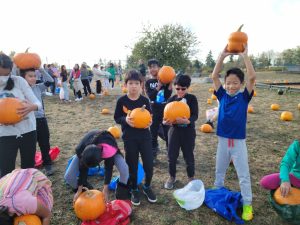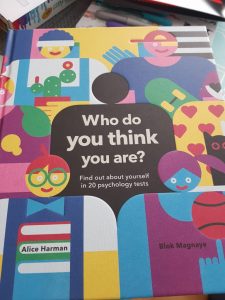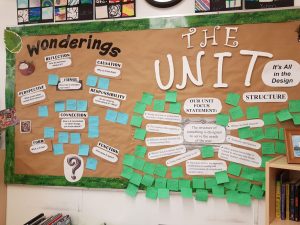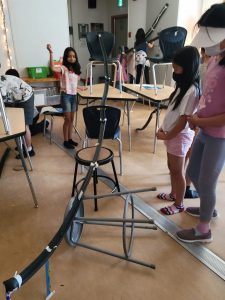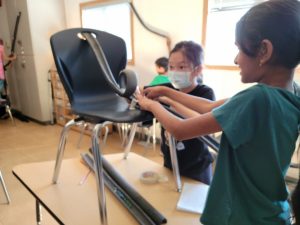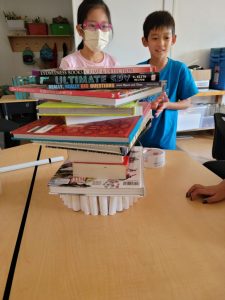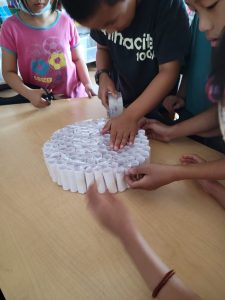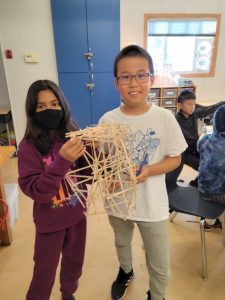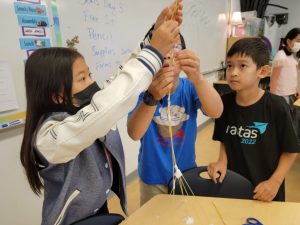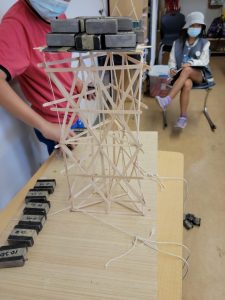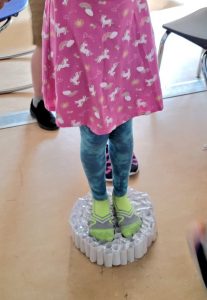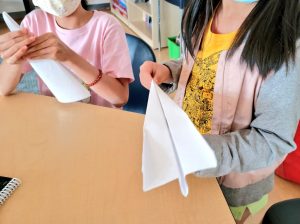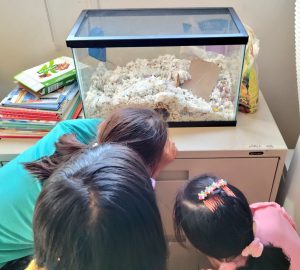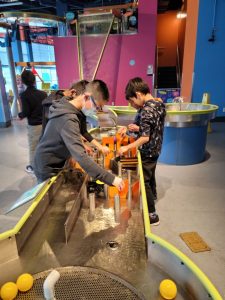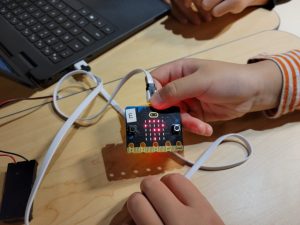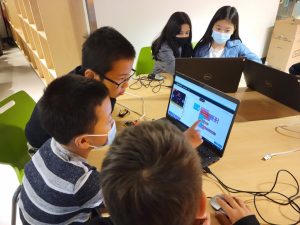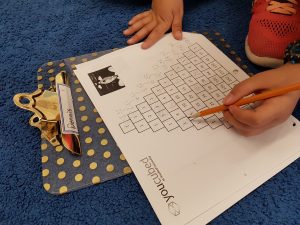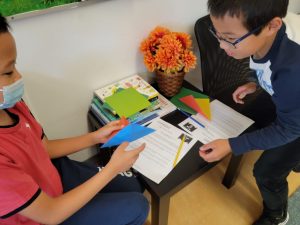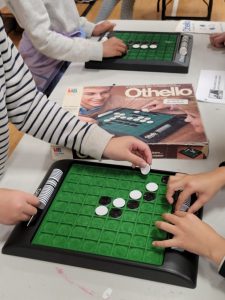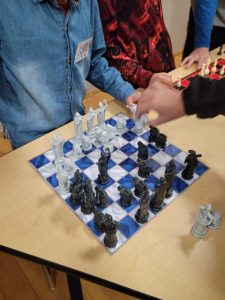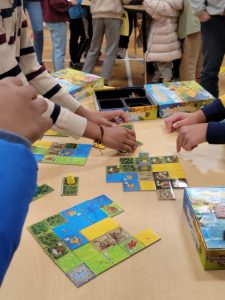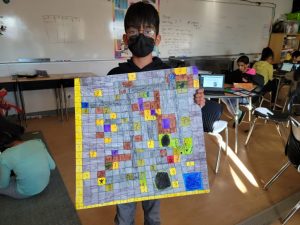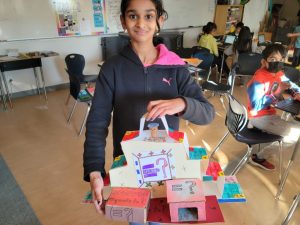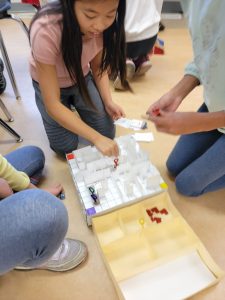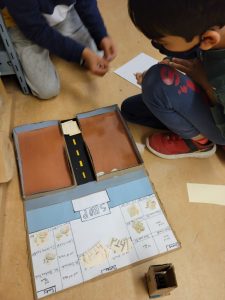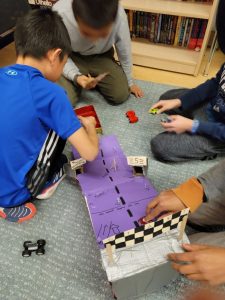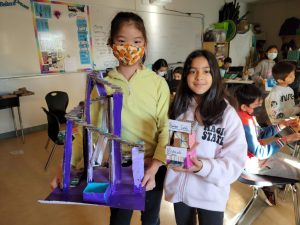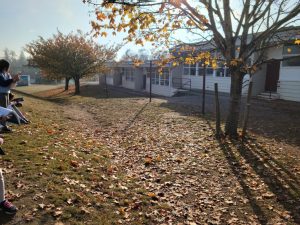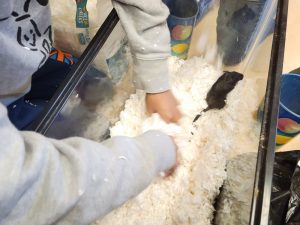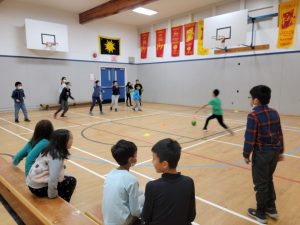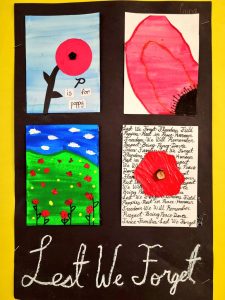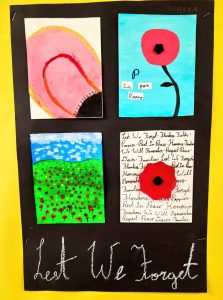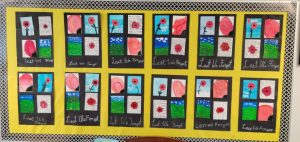Overview for Report Card Fall Term 1 2022
MACC Suncrest Division 5 Report Card Overview
Term One 2022, September – November
In anticipation of receiving our Term One Reports in December, here is an overview of what we studied during the last 2.5 months! Please see each student’s e-portfolio for more specific information on their projects and learning.
We began the year building the foundation for a great working community!
Throughout many fun activities together we discussed and applied elements of the personal awareness core competency, and we made individual goals to improve our approach to learning. We made essential agreements for working together, and we did brainstorms about our interests for a new school year.
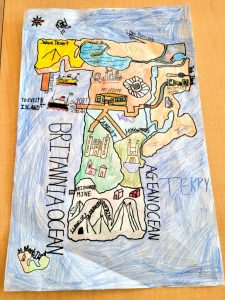
We created beautiful Life Islands to communicate our strengths and passions to one another; and we enjoyed playing games during Free Choice Fridays, which was a great opportunity to bond together as a class. We also learned how to run our own class meetings to plan events such as our Halloween party and drama contest in October. We enjoyed doing the Pumpkin Patch, and having hot chocolate with classmates!
We enjoyed doing psychology surveys from the book Who do you think you are?, which opened discussions about how everyone learns and experiences the world in different ways. In this way we could not only add to our own personal awareness, but also better understand our classmates and their needs.
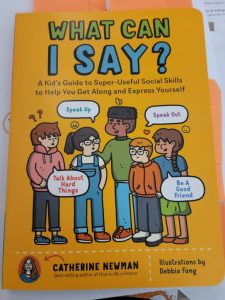 We also read from the book What Can I Say? A Kid’s Guide to Super-Useful Social Skills to Help You Get Along and Express Yourself, to help us discuss some of the social-emotional skills we need to collaborate well together.
We also read from the book What Can I Say? A Kid’s Guide to Super-Useful Social Skills to Help You Get Along and Express Yourself, to help us discuss some of the social-emotional skills we need to collaborate well together.
We began doing activities to start each day, called our RECALIBRATE TIME, which is time set aside for getting our materials ready, practicing mindfulness, and making the transition between the business of getting to school and starting our work. This can involve a class discussion, working on art, breathing, or doing some handwriting practice to focus.
Then we jumped right in to our conceptual units!
To tie the BIG IDEAS, content, and curricular competencies from our curriculum together into a larger, enduring understanding, we will study all subjects through the lens of universal, conceptual themes.
For our first unit, we focused on the concept of STRUCTURE
in our unit “It’s All in the Design”
Unit Focus Statement:
The structure of something is designed to serve the needs of the user.
Form Follows Function! – Building and Experimenting – Science
Through a variety of fun building activities, we discussed the scientific principles behind STRUCTURE. Many of our conversations revolved around the phrase “form follows function.” For example, we talked about how different sports balls have a specific design to serve a specific sport, and how our chairs were designed taking our ergonomic and daily work needs in mind.
Using critical and creative thinking, personal awareness and responsibility, and communication skills, we collaboratively designed and built marble roller coasters, popsicle stick towers, paper airplanes, rockets, and paper honeycomb structures based off of bee hive explorations to learn how certain shapes provide the greatest strength, and how understanding the science of our materials can help with design.
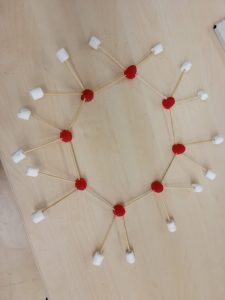 Through lab experiments, students learned about physical and chemical properties, atoms, forces, energy transfer, potential and kinetic energy, homogenous and heterogenous mixtures, solutions, and states of matter to better understand the structure of our world and how designers use this information to make new things!
Through lab experiments, students learned about physical and chemical properties, atoms, forces, energy transfer, potential and kinetic energy, homogenous and heterogenous mixtures, solutions, and states of matter to better understand the structure of our world and how designers use this information to make new things!
We also had discussions about how the human body has a certain form to serve specific functions related to our survival. We looked at the human skeleton, the eye, and cells, to better understand all of their structure. Then, we compared our skeleton to those of other animals to see how they are different.
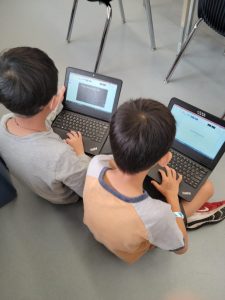
Our inquiry led us to looking at how different animals have structural and behavioural adaptations that allow them to survive in specific habitats. Again, form follows function! We had a virtual visit with the North Vancouver Ecology Centre for their workshop No Bones About It, to learn about adaptations in local animals, as well as how to look at specific bone features to identify which kind of animal they belong to.
Given we have class pets that are gerbils, we did some research on gerbil adaptations. We learned how to select websites for research, record our sources, ask questions, and organize our notes in our journal. Then we did a practice PowerPoint with a partner to share our gerbil findings with one another. Thank you Sage and Luna for being amazing class pets and science lab subjects!
Afterwards, each of us did research on an animal, building, or object of our choice. We made a PowerPoint of our own to show our overall understanding of STRUCTURE and form follows function, then presented it to the class.
Rumble Bots and Coding – Applied Design
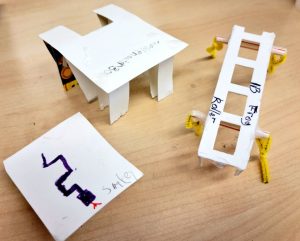 We used a lot of thinking, communication, collaboration, and creativity making Rumble Bots! After looking at energy transfer in guided science experiments with slinkies, and learning about potential and kinetic energy while creating fast roller coasters, we applied our knowledge of energy to the creation of cardboard Rumble Bots that raced on a vibrating track!
We used a lot of thinking, communication, collaboration, and creativity making Rumble Bots! After looking at energy transfer in guided science experiments with slinkies, and learning about potential and kinetic energy while creating fast roller coasters, we applied our knowledge of energy to the creation of cardboard Rumble Bots that raced on a vibrating track!
We also went on a field trip to Science World, learning how to do coding online with Micro:Bits to create a randomizer device! This was a great introduction for a later event in December, the Hour of Code, week-long event dedicated to learning code.
Structure of MATH Thinking and Our Number System
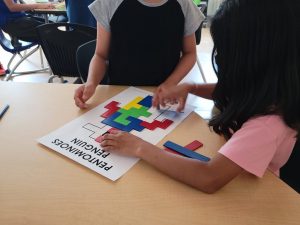 We talked about the STRUCTURE of our number system! We began by emphasizing the skills needed to be a successful mathematician, such as risk-taking, deep thinking, open-mindedness, questioning, and creative and critical thinking. We talked about how mathematicians work to prove and disprove conjectures, and we practiced being skeptics and convincers to question and to prove math understandings.
We talked about the STRUCTURE of our number system! We began by emphasizing the skills needed to be a successful mathematician, such as risk-taking, deep thinking, open-mindedness, questioning, and creative and critical thinking. We talked about how mathematicians work to prove and disprove conjectures, and we practiced being skeptics and convincers to question and to prove math understandings.
We also discussed the research of Prof. Jo Boaler and YouCubed at Stanford University, who talked about brain structure and the value of brain crossing, which involves doing two activities at the same time to better cement a concept in your head, such as drawing and math. We explored the question, “What does it mean to be a mathmatician?” This meant debunking the idea that math is all about the numbers (because you have to be able to explain your thinking, too), or that math is all about speed (because some of the best mathematicians have been some of the slowest, careful thinkers!)
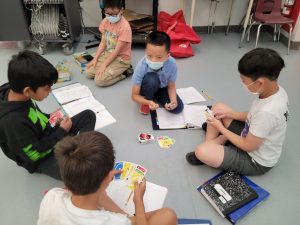 To explore the structure of numbers, we completed a variety of independent math tasks to understand how we break down our number system, to discuss strategic thinking through games, and to explore new ways to apply brain crossing while practicing grade-level curriculum in multiplication, area/perimeter, and patterns.
To explore the structure of numbers, we completed a variety of independent math tasks to understand how we break down our number system, to discuss strategic thinking through games, and to explore new ways to apply brain crossing while practicing grade-level curriculum in multiplication, area/perimeter, and patterns.
Many of these tasks involved reading non-fiction resources for math history information, such as the history of zero or the biography of Archimedes, as well as answering critical-thinking questions about math games, strategy, patterns, and the structure of number systems.
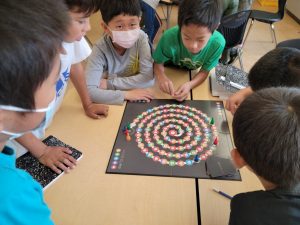 We looked carefully at a unique game called Prime Climb by the mathematician/teacher Dan Finkel, discussing how to win through strategic use of the four operations and knowledge of prime and composite numbers. We also did some key math content for this grade level, solving problems in the book You Do the Math Flight, which offers an opportunity to apply mathematical thinking directly to real life.
We looked carefully at a unique game called Prime Climb by the mathematician/teacher Dan Finkel, discussing how to win through strategic use of the four operations and knowledge of prime and composite numbers. We also did some key math content for this grade level, solving problems in the book You Do the Math Flight, which offers an opportunity to apply mathematical thinking directly to real life.
I am very proud of our class, as many of the students served as leaders in our Suncrest community by teaching others how to play the math games we analyzed in class. Thank you to everyone who volunteered for our Family Math Games Night, which was attended by almost 250 people in our community.
There was also the opportunity to apply our learning to the creation of a strategic math game! Working individually or with a partner, we created 3D, board, and card games, and shared them with other classmates.
Structure of a Healthy Community and World – Social Studies / PE & Health
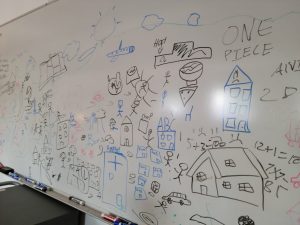 What kinds of structure are needed to support human life on Earth? We discussed the structure that allows our world to function, such as resource-delivery systems, government, city services, languages for communication, the nature of the land, and the Goldilocks Principle so our Earth is located in just the right place in the universe. We did a free for all brainstorm on the board of all the things we would need in a community. After we were done, we discussed how if we didn’t have structure, our life would be as chaotic as our whiteboard!
What kinds of structure are needed to support human life on Earth? We discussed the structure that allows our world to function, such as resource-delivery systems, government, city services, languages for communication, the nature of the land, and the Goldilocks Principle so our Earth is located in just the right place in the universe. We did a free for all brainstorm on the board of all the things we would need in a community. After we were done, we discussed how if we didn’t have structure, our life would be as chaotic as our whiteboard!
What is the structure of a healthy life?
We talked about the balance of work and play, as well as the importance of self-care — breathing, managing stress, mindfulness, taking breaks using our break board, staying healthy by washing hands, and getting enough sleep.
We learned about the importance of taking healthy risks, to get out of our comfort zone to do real learning! We explored alternative ways to get exercise and improve our focus, such as playing with devil sticks!
During recalibrate time and class meetings, we discussed strategies for self-regulation: breathing; learning vocabulary for expressing your emotions and needs to others; getting outside for breaks; understanding our own and others’ personal space; watching the class pet; getting enough sleep; making time for PLAY; using fidgets or alternative types of seating to better focus; talking to a trusted adult about our needs; and using the break board to get up and move every 10 minutes. This self-management is an important part of our learning in MACC!
With Mr. Chau in the gym, we did a running and volleyball unit, and we also played our favourite game as a class — dodge ball! Some of us even chose to participate in dodge ball during lunch. We discussed how organizing games and getting exercise are positive ways to use our outside playground time.
To apply our learning, we did the Your World Project, creating our own planets! We had to think about the planet’s place in the universe, the topographical features of the planet, the nature of its inhabitants, their language and government, and other elements of structure in the communities of the planet that allow the inhabitants to thrive. We look forward to hearing more about these creative planets as we share in class beginning in term two.
Structure of Language – Language Arts and French
Throughout all of the subject areas, as we communicated our ideas, we talked about the structure of language. We evaluated the elements of a good paragraph, we used homophones to play with language and make puns and jokes, and we discussed tools that help us with quality writing structure such as transition words. We documented our learning daily in our journals, shared ideas with partners, and wrote speeches, raps, and poems to demonstrate our understandings of mathematical concepts. After practicing how to make our sentences more complex, and how to make a proper paragraph, we applied this knowledge to several projects.
To help with our research on projects, we learned about non-fiction features we can use to help find information, how to record resources, how to look for legitimate websites, and how to ask different levels of inquiry questions. We will continue to use this in term three as we work toward our independent projects!
In French, we explored beginning vocabulary and phrases, and we discussed how brain crossing is important for helping cement new language in our brains! To memorize a new word, trying saying it, writing it, AND finding a way to MOVE that reminds you of the word. The doing of all these things helps your brain to record the word more permanently.
Elements and Principles – Playing with Structure in Art
We experimented with new materials, line, colour, form, texture and more through our art this term. We created amazing mixed-media art about poppies for the Remembrance Day Assembly, using a variety of materials and techniques, as well as line, colour, texture, shape, perspective, and emphasis. We also learned how to ZENTANGLE (which is an excellent recalibration and mindfulness art tool) and began creating watercolour trees for winter, which will soon be displayed at the front of the school. Great work, Division 5!

